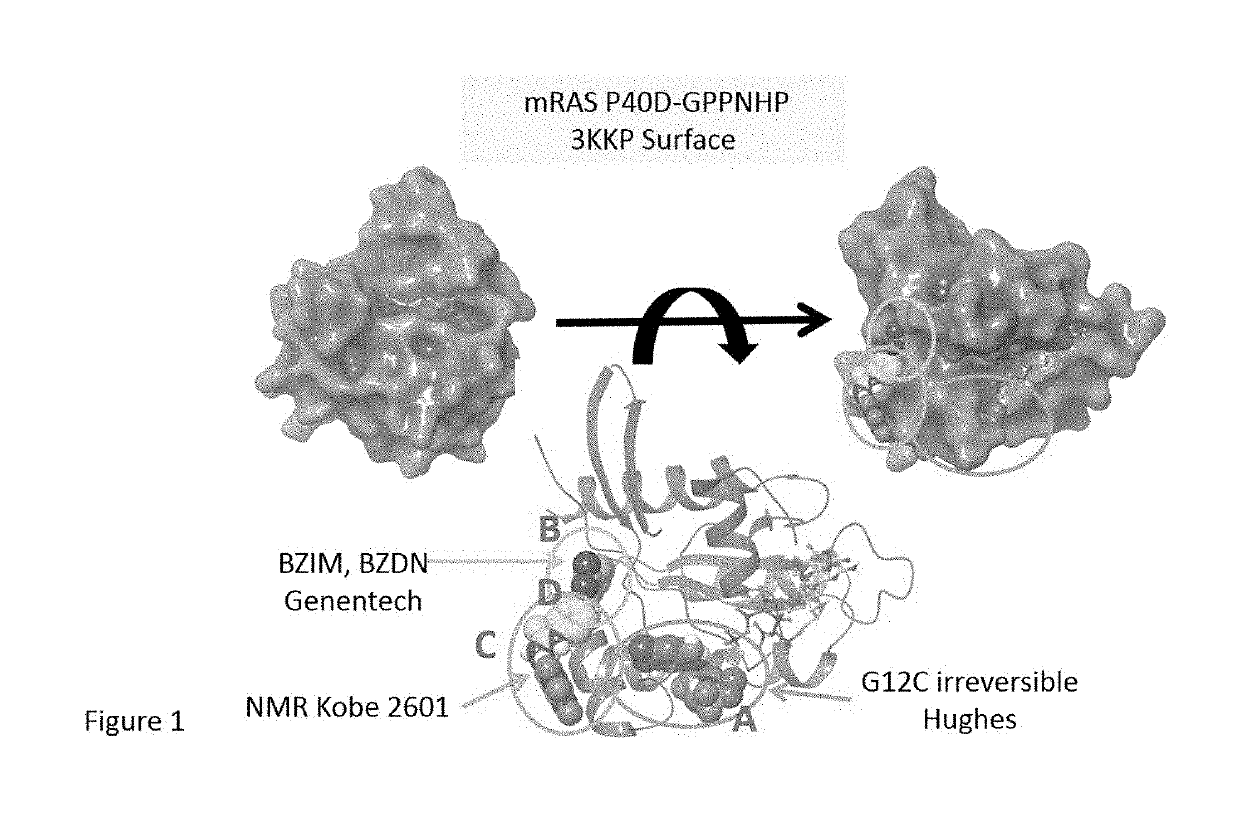K-ras mutations and antagonists
a technology of k-ras and antagonists, which is applied in the field of mutations of kras polypeptides and polynucleotides encoding mutant kras polypeptides, can solve the problems of inability to reverse covalent modification, difficulty in developing small-molecule inhibitors of k-ras, and inability to meet the needs of patients,
- Summary
- Abstract
- Description
- Claims
- Application Information
AI Technical Summary
Benefits of technology
Problems solved by technology
Method used
Image
Examples
example 1
Screen
[0140]Compounds that may bind to site A (also referred to as the “irreversible site”) were first identified by substructure searches of the eMolecules structural database to find reversible “analogs” of compounds covalently bound in mutant K-Ras X-ray structures. Next, high-throughput docking was performed with a processed version of the eMolecules structural database (prepared with 3D coordinates representing a sampling of relevant or reasonable protonation states, isomers, tautomers, and conformers), a computationally prepared K-Ras(G12C) protein model derived from a suitable X-ray structure, and Glide software (Schrödinger), followed by spot-checking with Gold software (The Cambridge Crystallographic Data Centre). Also, similarity searches of the eMolecules structural database identified additional analogs of selected compounds that were first discovered by substructure searches or high-throughput docking and later found to be active in assays described herein.
example 2
d K-Ras Mutants
[0141]The human K-Ras protein (Accession Number P01116) was engineered to include an N-terminal His6 tag, followed by the TEV protease cleavage site (ENLYFQ↓G, highlighted in Table 1 below) immediately before the start codon encoding methionine (underlined in Table 1). The mutation sites are shown with a double underline (e. “” in G12C).
TABLE 1K-Ras Constructs UsedKRAS(1-169)Sequence (including His6-tag and TEV cleavage site) 1.WT 2.G12C 3.G12C / S17V 4.G12C / T20I 5.G12C / T20F 6.G12C / I55F 7.G12C / D57E 8.G12C / D57F 9.G12C / D57R10.G12C / T58A11.G12C / T58V12.G12C / T58F13.G12C / G60A14.G12C / G60W15.G12C / Y71W16.G12V
example 3
ion of GDP-Bound His6-K-Ras(1-169) Proteins
[0142]The pET28b vectors harboring His6-K-Ras(1-169) mutants were transformed into E. coli BL21(DE3) (Novagen). Cultures (typically 2 L) derived form single colonies were grown at 37° C. in LB medium containing 50 μg / ml kanamycin until A600 reaches 0.6-0.8. The culture was chilled on ice for 30 min, then His6-K-Ras expression was induced with 1 mM isopropyl β-D-thiogalactoside (IPTG). Incubation was continued at 23° C. overnight. Cells were harvested by centrifugation using an SLA 3000 rotor at 5,000 rpm for 20 min, and cells were stored at −80° C.
[0143]All subsequent procedures were carried out at 4° C. Cell pellets were suspended in buffer A (50 mM Tris / HCl and 500 mM NaCl) and 1:20000 ratio of Benzonase® Nuclease (Sigma, 250 units / μL) was added. The suspensions were mixed gently for at least 30 min, and the cells were lysed by microfluidizer. The insoluble material was removed by centrifugation at 14,000 rpm in an SLA1500 rotor for 45 mi...
PUM
| Property | Measurement | Unit |
|---|---|---|
| enantiomeric excess | aaaaa | aaaaa |
| enantiomeric excess | aaaaa | aaaaa |
| enantiomeric excess | aaaaa | aaaaa |
Abstract
Description
Claims
Application Information
 Login to View More
Login to View More - R&D
- Intellectual Property
- Life Sciences
- Materials
- Tech Scout
- Unparalleled Data Quality
- Higher Quality Content
- 60% Fewer Hallucinations
Browse by: Latest US Patents, China's latest patents, Technical Efficacy Thesaurus, Application Domain, Technology Topic, Popular Technical Reports.
© 2025 PatSnap. All rights reserved.Legal|Privacy policy|Modern Slavery Act Transparency Statement|Sitemap|About US| Contact US: help@patsnap.com



